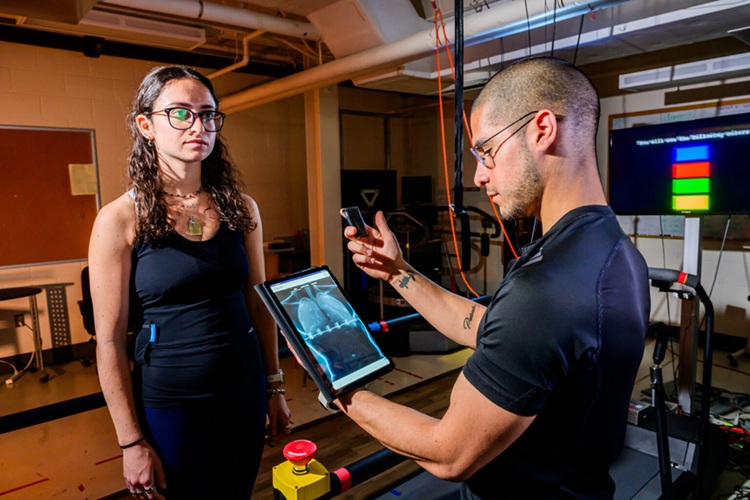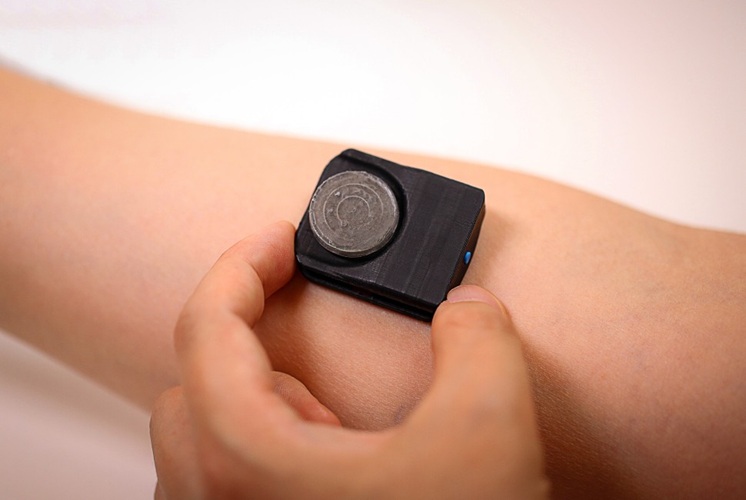Robotic Device Helps Stroke Survivors Recover Movement
|
By HospiMedica International staff writers Posted on 22 Jun 2017 |

Image: An experimental setup for the estimation of 3DOF human forearm and wrist impedance (Photo courtesy of UNIST).
A new study describes how robotic-assisted rehabilitation therapy can assess muscle activity and movement dysfunction in stroke survivors, helping to improve their mobility.
Developed by researchers at Ulsan National Institute of Science and Technology (UNIST; Republic of Korea), Korea Advanced Institute of Science and Technology (KAIST; Daejeon, Republic of Korea) and other institutions, the rehabilitation robotic system measures forearm prono-supination, wrist flexion-extension, and radial-ulnar deviation (collectively known as the three degree-of-freedom (3DOF) impedance in just minutes. The system uses the distal internal model based impedance control (dIMBIC)-based method, which accurately characterizes the 3DOF forearm and wrist impedance, including inertia, damping, and stiffness.
The accuracy and reliability of the system were experimentally validated using a robot with substantial nonlinear joint friction. The 3DOF human forearm and wrist impedance of eight healthy subjects was reliably characterized, and its linear behavior helped verify the dIMBIC-based method. The researchers suggest that dIMBIC 3DOF impedance estimation can promote motor control studies and complement the diagnosis of altered wrist and forearm resistance post-stroke by providing objective impedance estimates, including cross-coupled terms. The study was published in the May 2017 issue of IEEE Transactions on Neural Systems and Rehabilitation Engineering.
“The dIMBIC-based method can be used to assist in the quantitative and objective evaluation of neurological disorders, like stroke,” said senior author Professor Sang Hoon Kang, PhD, of the UNIST department of system design and control engineering, robotics, and rehabilitation engineering laboratory. “Findings from this study will open a new chapter in robot-assisted rehabilitation in the workplace accident rehabilitation hospitals, as well as in nursing homes and assisted living facilities.”
Human upper limb movement has been studied in detail, with the basic movements defined as roll – a rotational movement; yaw – a sideways movement in a horizontal plane; and pitch – an up and down movement in vertical plane. The human upper limb has seven degrees of freedom - three in the shoulder, one in the elbow, and another three in wrist.
Related Links:
Ulsan National Institute of Science and Technology
Korea Advanced Institute of Science and Technology
Developed by researchers at Ulsan National Institute of Science and Technology (UNIST; Republic of Korea), Korea Advanced Institute of Science and Technology (KAIST; Daejeon, Republic of Korea) and other institutions, the rehabilitation robotic system measures forearm prono-supination, wrist flexion-extension, and radial-ulnar deviation (collectively known as the three degree-of-freedom (3DOF) impedance in just minutes. The system uses the distal internal model based impedance control (dIMBIC)-based method, which accurately characterizes the 3DOF forearm and wrist impedance, including inertia, damping, and stiffness.
The accuracy and reliability of the system were experimentally validated using a robot with substantial nonlinear joint friction. The 3DOF human forearm and wrist impedance of eight healthy subjects was reliably characterized, and its linear behavior helped verify the dIMBIC-based method. The researchers suggest that dIMBIC 3DOF impedance estimation can promote motor control studies and complement the diagnosis of altered wrist and forearm resistance post-stroke by providing objective impedance estimates, including cross-coupled terms. The study was published in the May 2017 issue of IEEE Transactions on Neural Systems and Rehabilitation Engineering.
“The dIMBIC-based method can be used to assist in the quantitative and objective evaluation of neurological disorders, like stroke,” said senior author Professor Sang Hoon Kang, PhD, of the UNIST department of system design and control engineering, robotics, and rehabilitation engineering laboratory. “Findings from this study will open a new chapter in robot-assisted rehabilitation in the workplace accident rehabilitation hospitals, as well as in nursing homes and assisted living facilities.”
Human upper limb movement has been studied in detail, with the basic movements defined as roll – a rotational movement; yaw – a sideways movement in a horizontal plane; and pitch – an up and down movement in vertical plane. The human upper limb has seven degrees of freedom - three in the shoulder, one in the elbow, and another three in wrist.
Related Links:
Ulsan National Institute of Science and Technology
Korea Advanced Institute of Science and Technology
Latest Patient Care News
- Portable Biosensor Platform to Reduce Hospital-Acquired Infections
- First-Of-Its-Kind Portable Germicidal Light Technology Disinfects High-Touch Clinical Surfaces in Seconds
- Surgical Capacity Optimization Solution Helps Hospitals Boost OR Utilization

- Game-Changing Innovation in Surgical Instrument Sterilization Significantly Improves OR Throughput
- Next Gen ICU Bed to Help Address Complex Critical Care Needs
- Groundbreaking AI-Powered UV-C Disinfection Technology Redefines Infection Control Landscape
- Clean Hospitals Can Reduce Antibiotic Resistance, Save Lives
- Smart Hospital Beds Improve Accuracy of Medical Diagnosis
- New Fast Endoscope Drying System Improves Productivity and Traceability
- World’s First Automated Endoscope Cleaner Fights Antimicrobial Resistance
- Portable High-Capacity Digital Stretcher Scales Provide Precision Weighing for Patients in ER
- Portable Clinical Scale with Remote Indicator Allows for Flexible Patient Weighing Use
- Innovative and Highly Customizable Medical Carts Offer Unlimited Configuration Possibilities
- Biomolecular Wound Healing Film Adheres to Sensitive Tissue and Releases Active Ingredients
- Wearable Health Tech Could Measure Gases Released From Skin to Monitor Metabolic Diseases
- Wearable Cardioverter Defibrillator System Protects Patients at Risk of Sudden Cardiac Arrest
Channels
Critical Care
view channel
Novel Intrabronchial Method Delivers Cell Therapies in Critically Ill Patients on External Lung Support
Until now, administering cell therapies to patients on extracorporeal membrane oxygenation (ECMO)—a life-support system typically used for severe lung failure—has been nearly impossible.... Read more
Generative AI Technology Detects Heart Disease Earlier Than Conventional Methods
Detecting heart dysfunction early using cost-effective and widely accessible tools like electrocardiograms (ECGs) and efficiently directing the right patients for more expensive imaging tests remains a... Read more
Wearable Technology Predicts Cardiovascular Risk by Continuously Monitoring Heart Rate Recovery
The heart's response to physical activity is a vital early indicator of changes in health, particularly in cardiovascular function and mortality. Extensive research has demonstrated a connection between... Read more
Wearable Health Monitoring Device Measures Gases Emitted from and Absorbed by Skin
The skin plays a vital role in protecting our body from external elements. A key component of this protective function is the skin barrier, which consists of tightly woven proteins and fats that help retain... Read moreSurgical Techniques
view channel
Intravascular Imaging for Guiding Stent Implantation Ensures Safer Stenting Procedures
Patients diagnosed with coronary artery disease, which is caused by plaque accumulation within the arteries leading to chest pain, shortness of breath, and potential heart attacks, frequently undergo percutaneous... Read more
World's First AI Surgical Guidance Platform Allows Surgeons to Measure Success in Real-Time
Surgeons have always faced challenges in measuring their progress toward surgical goals during procedures. Traditionally, obtaining measurements required stepping out of the sterile environment to perform... Read moreHealth IT
view channel
Printable Molecule-Selective Nanoparticles Enable Mass Production of Wearable Biosensors
The future of medicine is likely to focus on the personalization of healthcare—understanding exactly what an individual requires and delivering the appropriate combination of nutrients, metabolites, and... Read more
Smartwatches Could Detect Congestive Heart Failure
Diagnosing congestive heart failure (CHF) typically requires expensive and time-consuming imaging techniques like echocardiography, also known as cardiac ultrasound. Previously, detecting CHF by analyzing... Read moreBusiness
view channel
Expanded Collaboration to Transform OR Technology Through AI and Automation
The expansion of an existing collaboration between three leading companies aims to develop artificial intelligence (AI)-driven solutions for smart operating rooms with sophisticated monitoring and automation.... Read more

















